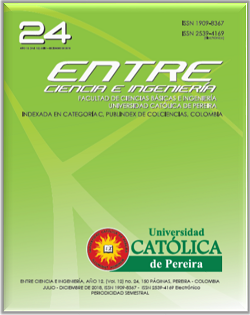Calculation and analysis of the maximum annual effi ciency of solar trackers
DOI:
https://doi.org/10.31908/19098367.3812Abstract
A standard methodology is proposed in thiswork to calculate the effi ciency of solar trackers for anygeographical latitude. A literature review was performed,and related articles were selected. Following an analysis ofthe information, a dispersion of the reported results withrespect to the mean value was identifi ed. An algorithm wasdeveloped to calculate theoretical maximum energy effi ciency,based on a scientifi c review of the concept of effi ciency. Thealgorithm was programmed and ran according to the latitudein the reports. Maximum values of theoretical effi ciencywere obtained for each of the reported latitudes, presentingsignifi cant diff erences regarding the data presented by theauthors. No clear methodologies for calculating the effi ciencyof solar trackers were identifi ed in the articles studied. Theproposed methodology be used as a reference, given that thereal effi ciency cannot be greater than the theoretical. Keywords— Effi ciency of solar tracker, maximum theoreticaleffi ciency, methodology calculation, mobile support.
Downloads
References
Kanyarusoke, K., Gryzagoridis, J. and Oliver, G., “Are solar trackingtechnologies feasible for domestic applications in rural tropicalAfrica?”, J. of Energy in Southern Afric, vol. 26, no. 1, pp. 86–95,2015.
Mehrtash, M. et al., “Performance Evaluation of Sun TrackingPhotovoltaic Systems in Canada”, in 20th Annual Int. Conference onMechanical Engineering ISME2012, School of Mech. Eng., ShirazUniversity, Shiraz, Iran. Performance pp. 18–21, 2012.
Kusekar, S., “Tracking of Solar Panel by Hydraulic System”, Int.J. of Informative & Futuristic Research (IJIFR), vol. 2, no. 8, pp.2856–2881, 2015.
Specifications of solar trackers used for photovoltaic systems, IEC62108 Int. Electrotechnical Commission, pp. 3–26, 2007 [Online].Available:https://www.google.com.co/url?sa=t&rct=j&q=&esrc=s&source=web&cd=1&cad=ja&uact=8&ved=0ahUKEwiWsP_K79PSAhVI9mMKHW3nAgwQFgg5MAA&url=http%3A%-2F%2Fstandardsproposals.bsigroup.com%2Fhome%2Fgetpdf%2F534&usg=AFQjCNGZL0ud2i0rCcUPCf7gGRhqXzENSw&sig2=ZDm9QDIlMlOQqDcpcnpK_Q [Consulted:
-15-2017].
Valcárcel, J. and González, H, “Application of Technological Systems of Solar Energy Conversion”, Entre Ciencia e Ingeniería, Año 5. No. 9, pp. 9 – 17, 2011.
Rumbayan, M. and Dwisnanto, M., “A Concept of Solar Tracker System Design”, Int. J. of Engineering Sciences & Research Technology, vol 6. (11), November 2017, pp. 440-448 DOI: 10.5281/ zenodo.1066204, 2017.
Rizman, Z. et al., “Design a Simple Solar Tracker for Hybrid Power Supply”, J. of Fundamental and Applied Sciences, 10 (2S), pp. 333- 346, February 2018.
Eberechi, R. and Nyebuchi, H., “Design and Implementation of an Off-Grid Solar Tracker Control System using Proteus Version 8.1”, IOSR Journal of Engineering (IOSRJEN), vol. 08, Issue 4, pp. 04- 12, April 2018.
Morón, C. et al., “New Prototype of Photovoltaic Solar Tracker Based on Arduino”, Energies (MDPI), vol. 10, 2017, pp.1-13; doi:10.3390/en10091298, 2017.
Ganesh, J. et al., “Design and Development of a Sun Tracking mechanism using the Direct SMA actuation”, Dept. of Mech. Eng., Texas A&M University, College Station, TX, USA, 2011 [Online]. Avalilable: https://www.researchgate .net/ publication/277371404_ Design_and_Development_of_a_Sun_Tracking_Mechanism_ Using_the_Direct_SMA_Actuation [Consulted: 02-03-2017].
Odeh, S. and Abu-Mulaweh, H., “Design and development of an educational solar tracking parabolic trough collector system”, Global J. of Eng. Educ., vol. 15, no. 1, pp. 21–27, 2013.
Clifford, M. and Eastwood, D., “Design of a novel passive solar tracker”, Solar Energy, vol. 77, pp. 269–280, 2004.
Al-Mohamad, A., “Efficiency improvements of photo-voltaic panels using a Sun-tracking system”, Appl. Energy, vol. 79, pp. 345–354, 2004.
Huang, B. J., Ding, W. L. and Huang, Y. C., “Long-term field test of solar PV power generation using one-axis 3-position sun tracker”. Solar Energy, vol. 85, no. 9, pp. 1935–1944, 2011.
Hsing, A., “Solar Panel Tracker”, Elect. Eng. Dept., California Polytechnic State University San Luis Obispo, 2010. [Online]. Available: http://digitalcommons.calpoly. edu/cgi/ viewcontent .cgi? article=1060&context=eesp [Consulted 01-10-2017].
Absallah, S. and Bradan, O., “Sun tracking system for productivity enhancement of solar still”, Sci. Direct Desalination, vol. 220, pp. 669–676, 2008.
Garg, A. et al., “Solar Tracking: An Efficient Method Of Improving Solar Plant Efficiency”, Int. J. of Elect. and Electron. Engineers, vol. 7, no. 1, pp. 199–203, 2015.
Kivrak, S., Gunduzalp, M. and Dincer, F. “Theoretical and experimental performance investigation of a two- axis solar tracker under the climatic condition of Denizli”, Turkey”, Przegląd Elektrotechniczny (Electrical Review), no. 2, pp. 332–336, 2012.
Tudorache, T., Oancea, C. and Kreindler, L., “Performance Evaluation of a Solar Tracking PV Panel”. U.P.B. Sci. Bull., Series C, vol. 74, pp. 3–10, 2012.
Dhanabal, R. et al., “Comparison of Efficiencies of Solar Tracker systems with static panel Single-Axis Tracking System and DualAxis Tracking System with Fixed Mount”, Int. J. of Eng. and Technology (IJET), vol. 5, no. 2, pp. 1925–1933, 2013.
Ghosh, S. and Roy, S., “Designing a Dual-Axis Solar Tracking System”, Int. J. Adv. Res. Electr. Electron. Instrum. Eng., vol. 5, no. 12, pp. 9039–9043, 2016.
Gupta, P. et al., “Azimuth-Altitude Dual Axis Solar Tracker”, IOSR J. Electr. Electron. Eng., vol. 11, No. 5, pp. 26–30, 2016.
Vij, K. and Kumar, R., “Theoretical Gain in Solar Energy for Different Sun Tracking Systems in Delhi”, Int. Advanced Research J. in Sci., Eng. and Technology, vol. 3, no. 7, pp. 213–218, 2016.
Duffie, J. A. and Beckman, W. A., Solar Engineering of Thermal Processes, 4th ed.; New Jersey: John Wiley & Sons, Inc., pp. 18- 928, 2013.
Chen, J., “Tracking sunlight”, in Physic of Solar Energy; New Jersey: John Wiley & Sons, Inc, ch. 4, pp. 77-104, 2011.






 Revista Entre Ciencia e Ingeniería
Revista Entre Ciencia e Ingeniería .png) entrecei@ucp.edu.co
entrecei@ucp.edu.co.png) ISSN (Impreso) 1909-8367 - ISSN (En Línea) 2539-4169
ISSN (Impreso) 1909-8367 - ISSN (En Línea) 2539-4169 Attribution-NonCommercial 4.0 International (CC By-NC 4.0)
Attribution-NonCommercial 4.0 International (CC By-NC 4.0)
.png) Carrera 21 No. 49-95 Av. de las Américas, Pereira, Risaralda, Colombia
Carrera 21 No. 49-95 Av. de las Américas, Pereira, Risaralda, Colombia